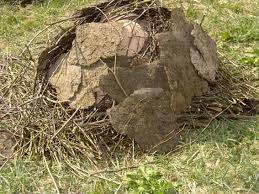You sod an piece of ground. Here you fire a light on. This you extinguish with e.g. moist bark or hay. Then you stack the also with some dry hay -filled pots, stable, opening down. Around the pots you pile wood. (Like when making charcoal and firing bricks.) Which is covered with sod. Via an air supply and a chimney you can give some times oxygen to the fire. Then you cover them off too. Allow the oven to burn and cool completely.
Often, about half of the content will fail.
 t is also possible to bake biscuit first in an open fire, and only then to accumulate timber and turf.
t is also possible to bake biscuit first in an open fire, and only then to accumulate timber and turf.
You can temper direct heating and cooling by placing dry cow manure around the pots and stacking the wood against it.
In our climate it’s less suitable for firing outdoors. With an oven you can reach heat above 900⁰C. With stacked bricks and soil cover, or clay or loam, you can build different types of kilns, with fuel around the pots, or below it, a chimney, cascade compartments (naborigama s), etc...
In a sawdust kiln you stack the pots filled with sawdust, in sawdust. You make a fire on top of it to light, and let him quietly, until one day burn out to the bottom. If you put wire mesh between the pots they do not fall down.
You can also create a permanent, loam oven (as for coal, iron ore, bread,.. )
Pots have to dry 1 to 3 weeks. The last moisture only disappears when heated. From 100°C
steam is formed, and must be slowly heated further. Between 450 and 800 degrees also chemically bound water is expelled. Around 600⁰C clay glows and compacts.
Above 850⁰C is: the hotter, the more solid and watertight clay becomes by glass molding or sintering. Depending on the size and thickness of the pieces they are fired 8 to 15 hours, and it takes twice as long to cool.
How can you keep quite some money as a potter? Start with a lot.
